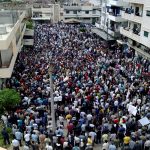by Derek Davison
During the 2016 presidential campaign, then-candidate Donald Trump was vocal about his plans, if elected, to escalate America’s war against terrorist networks like al-Qaeda and the Islamic State (ISIS or IS). He repeatedly accused former President Barack Obama of “weakness” in the fight against IS, at one point going so far as to call (sarcastically, Trump later said) him and Democratic nominee Hillary Clinton the “co-founders” of that organization. Most graphically, in November 2015, Trump told an approving audience that as president he would “bomb the shit out of” oil facilities under IS’s control. A couple of months later, in an interview on “Fox and Friends,” Trump decried Obama’s “politically correct” war on terror and said that “with the terrorists, you have to take out their families.”
Candidate Trump made it very clear, in other words, that his war on terror wouldn’t be constrained by efforts to minimize civilian casualties, or even by international law governing war crimes. President-elect Trump took things a step further, when his transition team reportedly began to examine “loosening the rules of engagement” for dealing with IS—including, presumably, restrictions related to potential civilian casualties. Two months into the Trump presidency, the consequences of his loosened rules of engagement are becoming clear, and they’re falling on everyone but the terrorists.
Civilians Are Getting Killed, and America Is Killing Them
The first sign that Trump’s war on terror was going to be more dangerous for civilians came on January 29, a scant nine days after he’d taken the oath of office. A Navy SEAL raid in Yemen’s Bayda province that day resulted in the deaths of as many as thirty civilians, including the eight year old American daughter of former Islamic preacher Anwar al-Awlaki, who was himself killed in a U.S. drone strike in 2012. That raid—which failed either to kill or capture its target, al-Qaeda in the Arabian Peninsula head Qassim al-Rimi—also saw a SEAL killed in the process, and raised a number of questions about the Trump administration’s decision to authorize an operation amid serious concerns that its secrecy had been compromised.
The day before the Yemen raid, Trump issued a national security memorandum ordering the Pentagon to submit to him within 30 days a “Plan to defeat ISIS.” The plan was to include, among other things, “recommended changes to any United States rules of engagement and other United States policy restrictions that exceed the requirements of international law regarding the use of force against ISIS.” Trump was already encouraging his military to push the envelope, if not break the seal.
The last two weeks have seen a series of high-casualty events linked to the U.S.-led coalition’s anti-IS air war in Syria and Iraq. On March 16, an airstrike hit a mosque in the Syrian village of al-Jinah, in western Aleppo province. At least 46 people were killed in the strike, which came as the mosque was filled with worshippers at evening prayers. The Pentagon initially denied responsibility for the strike despite photographic evidence from the scene that appeared to show the remnants of at least one American bomb. U.S. officials subsequently confirmed to Airwars.com that a strike indeed had been carried out in the “vicinity” of al-Jinah that evening while still insisting that it had targeted an al-Qaeda meeting place “across the street” from a mosque. But photos from the scene strongly suggest that it was in fact the mosque that was struck.
Regardless of the intended target, this strike may have been a war crime. International law protects places of worship in time of war, along with other civilian buildings like schools and hospitals, unless belligerents are actively using such a site to stage attacks. There are exceptions if the site is not directly targeted and if the military value of the actual target outweighs the collateral damage. In this case, it’s not even clear there was another target (the Pentagon still argues that it struck an “al-Qaeda meeting” that nobody else seems able to verify), and even if there was, the military value almost certainly wouldn’t have outweighed, to any objective observer, the killing of dozens of people at evening prayer. Perhaps the Trump administration saw things differently.
On March 22, the Syrian Observatory for Human Rights (SOHR) reported that a coalition airstrike had hit a school in the eastern Syrian village of al-Mansoura, just west of IS’s “capital,” Raqqa. The school had become a makeshift shelter for civilians fleeing Raqqa, either to escape IS rule or to get out ahead of the reportedly imminent US-organized operation to drive IS out of the city. The SOHR said that at least 33 people were killed in the strike. However, the activist group Raqqa Is Being Slaughtered Silently claimed that as many as 50 families had taken shelter at the school. Since any information coming from eastern Syria at this point can be nearly impossible to confirm, the true death toll may well have been higher.
In Iraq, government forces fighting to liberate the western half of Mosul from IS announced on Saturday that they were “pausing” their offensive in part because of a March 17 coalition airstrike that received little attention at the time but that now appears to have potentially killed hundreds of civilians, in what the Washington Post is calling “the biggest loss of civilian life in a single incident since the coalition’s air campaign began 2½ years ago.” The Pentagon has acknowledged that the coalition carried out a strike in Mosul’s Aghawat Jadidah neighborhood that apparently collapsed several apartment buildings. Casualty estimates are understandably difficult to obtain from a blast site in the middle of an active war zone, but it’s believed that over 200 people may have been killed.
U.S. military officials say that the damage may have been caused when a coalition bomb struck an explosives-packed IS vehicle that IS intended either for use against government forces or as a booby trap for coalition airstrikes. But even if true, the frequency of coalition airstrikes in western Mosul, a densely populated area that was estimated to still house as many as 700,000 Iraqis earlier this month, is further evidence that the Trump administration is treating potential civilian casualties less seriously than its predecessor. While American authorities say that nothing has changed in regards to civilian protections, Iraqi officers are saying that it’s “become much easier” to call in coalition air strikes since Trump took office. And taking the Mosul strike in conjunction with the other three incidents noted above, a pattern is beginning to emerge. Worse, however, may be yet to come.
Looming Disasters in Syria and Yemen
An Airwars.com report published March 17, before the Raqqa strike and before the horrific consequences of the Mosul strike were understood, found that the rate of civilian casualty incidents related to coalition airstrikes in Iraq and Syria so far in 2017 “has no precedent.” Where the site tracked 261 allegations of civilian casualties in all of 2015 and 454 in all of 2016, it recorded 245 just between January 1 and March 15 of this year.
To some extent this increase can be explained by the intensity of the Mosul operation. But it’s worth noting that the 2016 figure includes casualties from hard-fought campaigns to liberate the cities of Ramadi and Fallujah, as well as the opening phases of the Mosul operation. The Trump administration’s policy change thus seems clearly to be a contributing factor to the increase. As The Intercept’s Glenn Greenwald writes, “there seems little question that the number of civilians being killed by the U.S. in Iraq and Syria – already quite high under Obama – has increased precipitously during the first two months of the Trump administration.”
There are signs in eastern Syria that the current high rate of civilian casualties may be just the tip of a disturbingly large iceberg. As part of its preparations for the eventual assault on Raqqa, which will likely be spearheaded by the Kurdish-Arab Syrian Democratic Forces (SDF) with substantial American support, the Pentagon last week began airlifting SDF fighters toward the town of Tabqa, located west of Raqqa along the Euphrates River. Tabqa, and its associated dam on the Euphrates, are seen by U.S. planners as key IS strongholds that must be taken in order to isolate Raqqa before attacking it, but the fighting around the dam in particular has reportedly been fierce.
Therein lies the (possible) problem. On Sunday, the SOHR reported that IS was ordering an evacuation of Raqqa, on the grounds that coalition airstrikes had weakened the Tabqa Dam enough to pose a downriver flood risk. There have been conflicting reports about the credibility of this claim, with the U.S. insisting that the dam was structurally sound and that the SDF now controls a spillway north of the dam that could be used to alleviate water pressure if necessary. However, the United Nations began warning in mid-February about the risk of Tabqa Dam’s failure resulting from airstrikes, deliberate IS sabotage, unusually high water levels in the river, or some combination of all three, so IS’s alarm may not be entirely groundless. The Syrian government has also warned that coalition airstrikes are putting the dam at risk. And on Monday, the SDF “paused” its Tabqa offensive to allow engineers to inspect the dam, suggesting that there may be a genuine threat despite repeated American claims to the contrary.
Obviously, IS could be hyping the dam’s “imminent” failure as a way to force the US and SDF to ease up on their operations. It could be preparing to destroy the dam itself and cast blame on the coalition. It could even be planning to use a mass evacuation of Raqqa to extract its fighters and leadership from the city as part of a general exodus. It’s not clear whether Monday’s pause in the fighting was instigated by the SDF acting alone, or with input from Washington or Damascus, or both. Given what we’ve seen so far from the Trump administration with respect to civilian casualties, however, it seems fair to ask whether, if there were a genuine threat that the dam might fail, it would alter the administration’s war plan in any way.
Additionally, on March 26 Foreign Policy reported that the Pentagon is now “looking to increase support for Saudi Arabia’s two-year-old war against Houthi rebels in Yemen,” seeing it as a way to counter Iranian expansion in the Middle East. The Saudi-led, anti-Houthi coalition in Yemen has been accused of committing war crimes over a number of airstrikes that appear to have targeted Yemeni civilians, and it has further been accused of using mass starvation as a war tactic. Earlier this month, Amnesty International wrote a letter to Trump urging him not to increase support for the Saudi campaign in Yemen, in part due to what it called “serious concerns about [the coalition’s] apparent disregard for civilian life.” That letter was sent days before an Apache helicopter, almost certainly belonging to the coalition, opened fire on a boat full of refugees fleeing Yemen for Somalia, killing 42 people.
Why This Matters
The killing of civilians is obviously wrong on its face, but there are operational concerns here as well. To quote Greenwald again:
Trump’s reckless killing of civilians in Iraq, Syria and Yemen is many things: barbaric, amoral, and criminal. It is also, ironically, likely to strengthen support for the very groups – ISIS and Al Qaeda – that he claims he wants to defeat, given that nothing drives support for those groups like U.S. slaughter of civilians (perhaps the only competitor in helping these groups is another Trump speciality: driving a wedge between Muslims and the west).
Airwars’ Samuel Oakford wrote in December about the possibility that the Trump administration would look to modify or do away with Barack Obama’s executive order 13762, which was issued in 2016 and instructed relevant federal agencies to take steps to minimize civilian casualties in conflict zones. Oakford noted that even the Pentagon believes that it’s in America’s interests to proceed with caution when civilian lives may be on the line:
Earlier this year, Airwars director Chris Woods met with top officials at U.S. Central Command in Tampa, who insisted that civilian harm mitigation is central to the strategy of the anti-ISIS coalition currently bombing both Iraq and Syria.
“It wouldn’t make operational sense to just go into this bombing left and right you know?—?wiping out ISIL at the expense of the civilian population,” a senior CENTCOM official, using another popular acronym for Islamic State. “So there’s a humane aspect to it but also an operational aspect to it.”
Or to put it more bluntly, from Oakford’s March 17 report:
When discussing civilian deaths, many in the US military highlight recent developments in Afghanistan, where generals concluded after almost a decade of conflict that rising civilian casualties were undermining the NATO mission there, and proving an effective recruiting tool for the Taliban. Reforms were introduced via directives including the creation of a civilian tracking cell; more stringent targeting rules; and a top down emphasis on civilian protection as a mission critical concern. The measures by no means ended civilian casualties, but casualties caused by international airstrikes dropped steeply between 2008 and 2013.
In that context, Trump’s request “flies in the face of everything that was done in Afghanistan,” one former senior military intelligence officer who served in the country told Airwars.
In Afghanistan “IHL [International humanitarian law] was your lowest standard and then you are going up from there, and this is like IHL is your highest standard and the goal is how close to the chalk line can you get,” said the officer. “That’s really fucked up.”
The eventual defeat of IS and al-Qaeda requires not simply beating them on a battlefield or driving them out of a city. It requires undermining and discrediting their ideology. These groups, and their eventual successors, can survive indefinitely if the United States and its allies take actions that fuel Muslim resentment toward the West. In any war, some civilian casualties are unfortunately inevitable. But if the Trump administration has truly decided to “take the gloves off” in the war on terror, then it may find that it’s punching the wrong people.






From Vietnam to Iraq, to Libya and now Yemen and Syria, nations that just have to be destroyed in order to be saved.
One day, sanity will return to the Earth and that’s when war criminals, in the WH, Congress and media will be rounded up, sent to the ICC, tried and join their not-so-illustrious ancestors with their feet dance in the air.